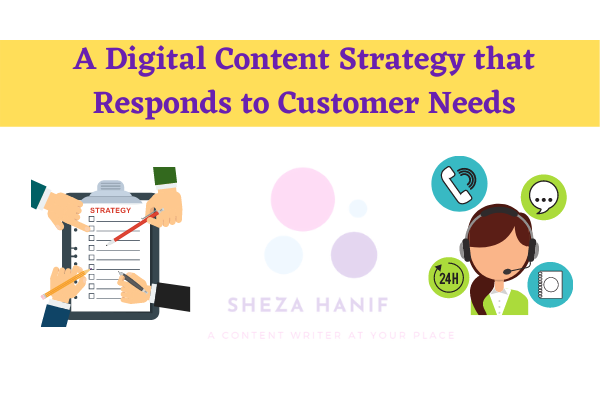When did you last consider the digital content strategy used within your organization?
Numerous studies show that organizations generate an average of 126% more leads when the content strategy is thought through and tailored to customer needs.
Within this blog, experience the four tools that shape your digital content strategy and the techniques that put you in the minds of your customers.
Why do you need a digital content strategy?
In general, you can say that the best optimization for a website is the delivery of high-quality content (so-called ‘content’) in combination with a solid structure.
In fact, sharing valuable content is so effective that it works better than advertising, according to research.
Why incorporating a strong digital content strategy into your sales funnel is so effective:
- 61% of consumers have ever bought something through a blog article
- 77% of internet users read blog articles
- 70% of consumers would rather get to know a company through content than through advertisements
Companies that blog actively receive an average of 80% more visitors to their website and generate an average of 126% more leads.
Pretty impressive numbers.
It is, therefore, not surprising that everyone starts with Content Marketing. The only problem is that not everyone will be successful with that. The success behind content marketing lies in your digital content strategy and in responding to customer needs.
An effective digital content marketing strategy in 4 steps
- Get into the minds of your visitors
- Discover the customer needs
- Optimize your content for Google
- Use the 6 ways of persuasion
Get into your visitor’s brain and hit the right note with your content
You don’t use digital content marketing because you only want extra visitors.
However?
What do you want to achieve?
Exactly, more customers.
How do you get more customers? By responding to the right need.
Before you even start, take a look at the product or service you want to promote.
View your product or service and ask yourself the following questions:
- Who buys my product, or who could buy my product?
- What situation should someone be in before buying my product/service?
- How does my product/service help the customer?
- What does someone do if he does not buy my product or service?
Imagine you are a painter:
- Who buys my product?
People who own a house, boat, garage, office, or anything that can be painted.
- What situation are my customers in?
People are just moving. Someone has the budget, so they want to outsource it. Someone doesn’t have time to do it themselves etc.
- How does my service help?
My department takes work off your hands, ensures that the paintwork is delivered tightly and professionally, etc.
- What does someone do if he does not buy my product or service? Sanding, masking, painting, lacquering, staining, etc.
How do you make a strong digital content strategy?
Situation: people are just moving;
- What should you pay attention to if you have just moved?
- How do you determine the colors for your new home?
- How does the sales value increase through the right painting
Not bought; people don’t hire a painter
- When painting with a brush is the best option.
- When painting with a roller does a better job.
- All the differences between paint that you didn’t know yet.
- The secret to brushing or roller painting.
Immerse yourself in your visitor. What situation is your visitor in before she/he becomes your customer? Once you have mapped out that situation, delve into the customer’s needs.
The phases of a customer need. Which ones do you respond to?
Based on a well-thought-out digital content strategy, you ensure that the carefully chosen blog topics match your customer’s needs. A process that has several phases that can follow each other at varying speeds.
The awareness
A need can build up slowly or suddenly arise out of nowhere.
What if, after years of loyal service, your phone or television breaks down.
No matter how long you keep staring at it, you won’t get it to work anymore.
There is a good chance that the need that arises will focus on replacing the appliance or making it.
Starting points where targeted blog topics in the next phase can respond smartly to both customer needs.
The search for information and answers
With the emergence of the customer need, the next phase, which focuses on finding information, quickly arrives. Thanks to the internet, and Google, the answer to most questions can be found quickly.
Do we stick to the example mentioned earlier? Then you have a good chance of becoming a bacon buyer if you can provide visitors with an answer to the following and many other relevant questions;
- What is a suitable television to enjoy sports matches as optimally as possible?
- Which televisions use the most or the least power?
- Which television does Netflix look best on?
- How good is the image/sound quality of the latest Smart televisions?
With the above blog topics as a first step, a recommendation can be made for each category that can strongly influence the buying decision of your readers.
Is your focus on this second phase? Then make sure that the information you provide helps your visitor to the next phase.
Alternatives that meet customer needs are evaluated
The third phase in the consumer’s buying process is devoted to evaluating all alternatives.
What options are there to meet the need that has just arisen?
The answer to this question can yield dozens if not hundreds of answers …
What now?
Do you know how to present a blog at that moment in which many of these alternatives are compared, including a top 3 ‘Best scoring in the test?’
The chances are that you will turn your visitors into your fans and that your recommendations will be followed when you encourage them to make a purchase.
Make the buying decision easier.
Whoever guides his or her visitor from phase 1 to phase 3 satisfactorily is far from certain of a sale.
Check it out for yourself.
No matter how well website A helped you decide, would you purchase if the same product was offered at half price through website B?
Or under more favorable conditions?
Especially if you provide a service, it pays to focus your content plan and the accompanying strategy on the visitors who enter this final phase.
What added value are they provided with by engaging your specialist,m or perhaps more importantly: how much time do they lose and how much hassle do they incur when they do not purchase your service and solve it themselves?
The better you succeed in showing your expertise and drawing up all the processes involved, the greater the sale.
Have you clearly mapped out customer needs and incorporated them into your digital content strategy?
Then now is the time to promote your content.
A strong digital content strategy and easy to score in Google
Since the Google Hummingbird update, Google has made it even clearer what really matters to them. It is no longer the keyword that gets the attention but the searcher itself.
Who is this person, what does Google know about him/her, and how does Google expect to help this person best?
By no longer focusing your content strategy on the keywords but a theme, you ensure that your article will score on more keywords and that your content will be attractive to a much larger audience.
Have you chosen a strong theme? Then make sure you optimize your brand new content for Google.
Organize your content in a search engine friendly way and score higher in Google
Okay, you’ve got your article ready (or you’re sensible and read on before you start). There are currently more than 200 factors that Google takes into account. Now it is going far too far to cover all factors in this article. That is why I discuss with you the most important elements to optimize your new content for a better position in Google:
- Optimize your title for Google
- Make smart use of cups
- Optimize your images
Optimize your title for Google
The title of your web page is the most important element that you can optimize on your website yourself. Include your most important keywords in your title, and make sure you get your visitor’s attention.
Make smart use of cups.
If you’re no exception to the rule, then you’ve quickly scrolled through the article, looked at some pictures and headlines, and then started reading. If you even belong to the fleeting visitor, you haven’t read anything at all and just started here. This is exactly how it goes on most websites.
Visitors come, read something, and go again. It’s up to you to keep people on your website for as long as possible. But how do you do that?
Make sure you make your headlines catchy and that you include the correct keywords in the headings.
Optimize your images
Google cannot read your images (yet). To tell Google what the image is about, you will have to optimize it.
How do you do that?
As soon as you save your images, you can start optimizing for a better position in Google. Save all your images with descriptive text or keywords.
Set an alt text
An alt text (alternative text) is the text that is displayed when an image cannot be loaded. With the following HTML code, you can add ALT text to your images.
This looks like this in HTML: <code> <img src = ”/ source-of-the-image” alt = ”your alternate text”> </code>
Give your image an online title
In addition to the alt text, you can also add a title to your image. <code> <img src = ”/ source-of-the-image” alt = ”your alternate text” title = ”your title”> </code>
Ready for your (first) digital content marketing campaign?
You have spent quite a bit of time reading this article. It has become a long article, so I think it is a great shame if you do not take action. Let me know which steps you are going to take and share your (first) article here.
If you have any questions, feel free to ask.


Nice blog! Thanks you all star articles good story!